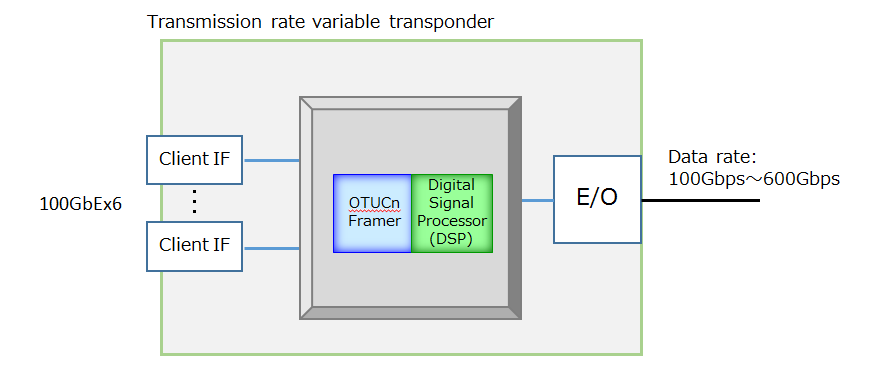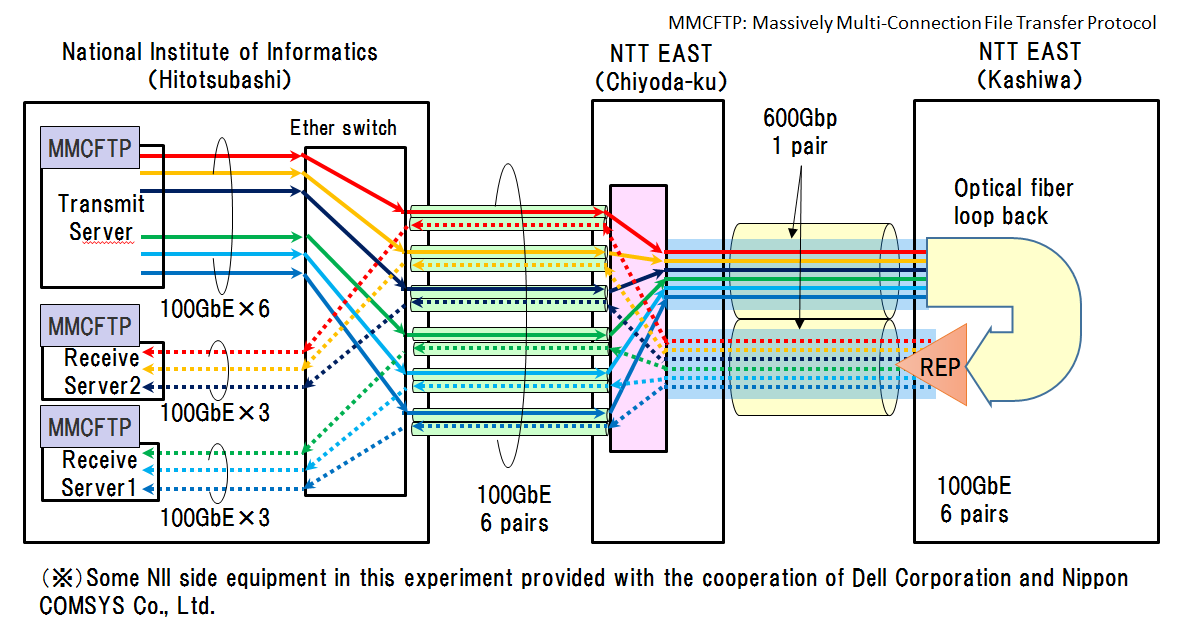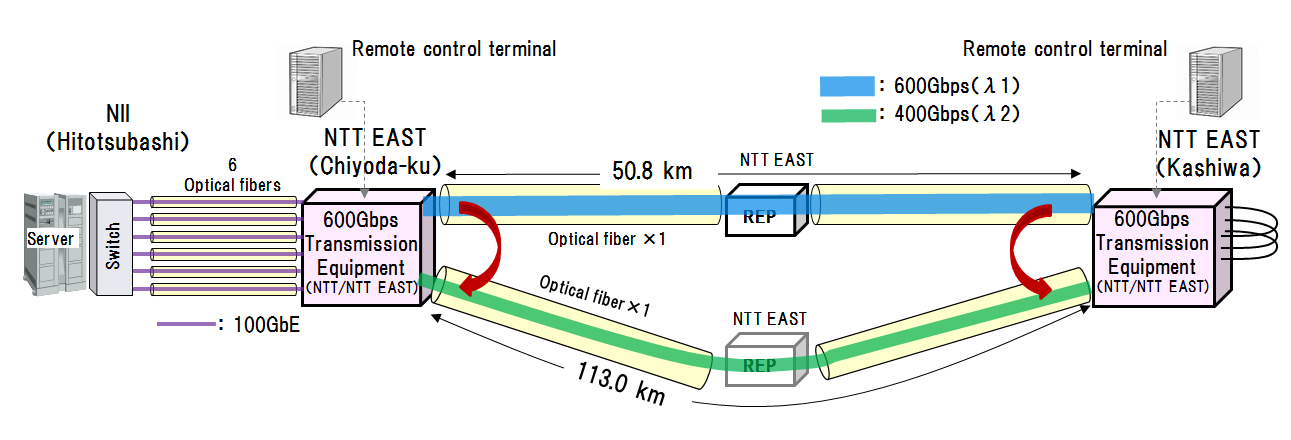News
News Release
Succeeded: World's fastest 600Gbps per lambda optical transmission with 587Gbps data transfer
~ Prospect for realizing 600Gbps per lambda optical network and data transfer protocol maximizing its utilization, aiming for ultra-fast transfer of big data yielded by advanced science and technology research ~
National Institute of Informatics (NII, Director General: Kitsuregawa Masaru, Chiyoda-ku, Tokyo) and Nippon Telegraph and Telephone East Corporation (NTT EAST, President: Fukuzo Inoue, Shinjuku-ku, Tokyo) and Nippon Telegraph and Telephone Corporation (NTT, President: Jun Sawada, Chiyoda-ku, Tokyo) today announce that they experimentally demonstrated that the communication with the data transfer rate of 587Gbps between general purpose servers on the 600Gbps per lambda optical transmission system spanning Tokyo and Chiba.
For this experiment, we constructed the world's longest transmission link with total distances of 102km over commercial field fiber at 600Gbps per lambda transmission system. In addition, we recorded the fastest data transfer rate of 587Gbps between one set of servers by applying "MMCFTP" (Massively Multi-Connection File Transfer Protocol)(*1) developed by NII for data transfer. Moreover, in order to realize highly-reliable optical network, we successfully demonstrated a flexible route switching with adaptive change of transmission rate from 600Gbps to 400Gbps and the optical wavelength conversion, considering the transmission distance of the optical signal.
Background
In April, 2016, NII commenced operating SINET5(*2) which is a Japanese nationwide 100-Gbps-lambda-based research and education network. SINET5 also provides high-speed connection to foreign research and educational networks in the US, Europe and Asia with a 100Gbps, 20Gbps (being upgraded to 100Gbps soon) and 10Gbps (being upgraded to 100Gbps soon) international line, respectively. Advanced science and technology fields such as high-energy physics, nuclear fusion physics and astronomy, use SINET5 to transfer the big data generated by experimental devices and computing resources. Currently, 100Gbps data transfers on SINET5 are actively performed among domestic research institutes and demands for higher data transfer rate are rapidly increasing. Therefore, it is desired to respond to higher data transfer rate towards over 100Gbps.
Meanwhile, as an environment surrounding the NTT Group, data traffic is increasing rapidly on backbone optical networks due to expansion of distribution of big data and video data and progress of cloud technology. To respond to this situation, the NTT Group has continually conducted research and development and installed equipment, for the next generation of core optical networks.
Overview of Achievements
For experimental demonstration conducted in November 2018, we constructed an optical transmission system (Figure 1) capable of transmitting 600Gbps at single wavelength, between NII office (Hitotsubashi, Chiyoda-ku) and NTT EAST office (Kashiwa city). We successfully demonstrated three experiments.

《Figure 1》Schematic of field trial network
1. Experiment 1
For the 600Gbps transmission system, NTT introduced an adaptive-rate transponder(*3) supporting a variety of transmission rate ranging from 100Gbps to 600Gbps, by implementing the world's most advanced digital signal processing technology and OTUCn technology(*4) which enables the multiplexing up to six 100GbE client signal on one chip (Figure 2). NTT EAST constructed a network that can transfer data at 600Gbps and at 400Gbps in experiments. We verified the full throughput on 600Gbps per lambda signal by using data generated by test equipment. For the first time in the world, we could demonstrate 600Gbps transmission over commercial field fiber with total distances of 102km.

《Figure 2》Implementation image of the world's most advanced digital signal processing and OTUCn technologies
2. Experiment 2
In this communication environment, MMCFTP was used to transfer data from one server to two servers and data from two servers to one server (Figure 3). We successfully confirmed that large capacity data of 40TByte were transferred with the data transfer rate of 587Gbps and 590Gbps. For example, 40TByte is equivalent to 1,600 ordinary 25GByte Blu-ray discs, which means that you can transfer this large volume of data in about 9 minutes or you can transfer the volume of one Blu-ray disc in about 0.4 second. This result indicates a prospect of 587Gbps data transfer between one set of servers.

《Figure 3》Experimental system for data transfer
3. Experiment 3
We successfully demonstrated a data transfer function linked with the route switching function (Figure 4). At that time, we confirmed that a communication link was reestablished by an adaptive change of transmission rate from 600Gbps to 400Gbps with the optical wavelength conversion according to switching of transmission route.
The transmission rate of the optical signal before transmission route switching was 600Gbps, and the measured data transfer rate was 580Gbps. After switching to the long distance route, the transmission rate of the optical signal was switched and the measured data transfer rate was 393Gbps.

《Figure 4》Configuration of transmission path switching experiment
Part of this work is utilizing digital coherent optical transmission technology which is the result obtained in the research projects "The research and development project for the Tera-bit optical network technologies towards big data era" supported by the Ministry of Internal Affairs and Communications.
Future Work
At the state-of-the-art academic research, the Big data to be handled, which is generated by computer simulation science, high-performance experimental apparatus and sensors of IoT services etc., increase explosively. In order to transfer huge amount of data efficiency, NII will more enhance MMCFTP software and provide it for advanced science research project to stabilize and enhance data transfer rate in practical.
NTT EAST and NTT will continue to promote the development of large capacity transmission technologies in order to keep satisfying the traffic demand increase.
Related news releases
News Release: PDF
(*2) SINET5: Science Information NETwork 5. An ultra-high-speed academia network for about 900 universities and research institutions. SINET5 is used for sharing large experimental facilities and big data, strengthening cooperation in many research fields, promoting international collaboration with many countries, enhancing educational quality, making a university as a center of knowledge for regional revitalization and industry-academia cooperation. At least one SINET node is located in every prefecture in Japan and these SINET nodes are connected with 100Gbps or more links.
(*3) Transponder: An equipment having a function of transmitting and receiving optical signals.
(*4) OTUCn: A technology that accommodates services of over 100Gbps (such as ultra-high-speed Ethernet signaling) and reliably transmits data over optical networks.
This is a joint news release by the National Institute of Informatics (NII), Nippon Telegraph and Telephone East Corporation (NTT EAST) and Nippon Telegraph and Telephone Corporation (NTT).

 Summary of NII 2024
Summary of NII 2024 NII Today No.104(EN)
NII Today No.104(EN) NII Today No.103(EN)
NII Today No.103(EN) Overview of NII 2024
Overview of NII 2024 Guidance of Informatics Program, SOKENDAI 24-25
Guidance of Informatics Program, SOKENDAI 24-25 NII Today No.102(EN)
NII Today No.102(EN) SINETStream Use Case: Mobile Animal Laboratory [Bio-Innovation Research Center, Tokushima Univ.]
SINETStream Use Case: Mobile Animal Laboratory [Bio-Innovation Research Center, Tokushima Univ.] The National Institute of Information Basic Principles of Respect for LGBTQ
The National Institute of Information Basic Principles of Respect for LGBTQ DAAD
DAAD
